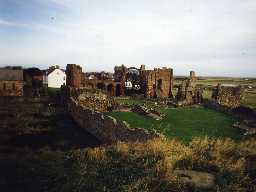Lindisfarne Priory (Holy Island)

Lindisfarne Priory, Holy Island. Photo by Northumberland County Council.
[NU 126417] Remains of Lindisfarne Priory (Benedictine founded D1081). (1)
See attached pamphlet. (2)
As described, and open to the public. (3)
Lindisfarne Priory, Grade I listed building. Ancient monument. Founded originally by St Aidan from Iona in AD 635. Re-founded as a cell of Durham in Norman times. Now extensive ruins in dark red sandstone. The church is almost entirely 12th century, originally with an apse but altered later in the century. Rib vaults in chancel and transepts. Nave piers similar to those at Durham. The ruins of the monastic buildings adjoin the south side, built in grey stone (like the parish church) in the 13th century and later. The west wall is well preserved but the rest is fragmentary. (4)
Lindisfarne Priory, Grade I. Ruined priory. Started c.1093. Church late 11th and early 12th centuries. Remains of 14th century window in left bay north wall. Chancel has one original window and several 14th century windows. Church lengthened in 1140-50. Extensive remains of monastic buildings to south. 13th and 14th century with barbican and gatehouse. (5)
Remains of Lindisfarne Priory (Benedictine founded AD 1081). (6)
Sceatta, Y series, found at Lindisfarne Priory Anglo-Saxon minster site in 1920-5. Aethelred I, animal on reverse. In Lindisfarne Museum (cast?). (7)
Island of Lindisfarne given to Aidan in 634 by Oswald. Monastery founded on Irish pattern, ruled by an abbot. The See and monastery existed for over 240 years. A few carved stones are all that remain of the early church and monastery, they date after Cuthbert (685-7).
Lindisfarne monastery sacked by the Danes in June 793. Monastic tradition continued until 875. The See remained fixed until 995 when Durham became the See of successors of Aidan and Cuthbert. Ruins visible today are those of the cell or priory founded by the Norman prior and convent of Durham. The name 'Holy Island' came into use at this time, superseding 'Lindisfarne'.
Priory was in ruins by 16th century. Excavation of the priory buildings began in 1888 by Sir William Crossman. Since transference to DOE the whole site has been cleared. [Detailed description of priory buildings]. (8)
Geophysical survey by Leicester University in 1984/5 in Sanctuary Close an open areas in the Priory. In the area of the outer court the resistivity meter revealed a number of features: the south line of the south cloister walk, north wall of the south range, and indications of a range of buildings parallel with the west wall of the outer court. In the Sanctuary Close several anomalies were recorded which may be pre-Conquest in origin. (9)
NU 1261 4172. Lindisfarne Priory pre-Conquest monastery and post-Conquest Benedictine cell. Scheduled RSM No 23235. Monastic remains of both periods will survive outside the precinct of the later monastery but these have not been included in the Scheduling as their extent and state of preservation is not yet sufficiently understood. Except for a number of 8th and 9th century carved stones, no remains of the pre-Conquest church and monastery have yet been found at Lindisfarne. The upstanding remains and current layout are entirely post-Conquest in origin. Full architectural and historical account. (10)
The Romanesque priory church may lie on the site of Cuthbert's Church of St Peter. The positioning of two churches on the same alignment has been shown to be characteristic of important Anglo-Saxon minsters, 'and the rebuilding of one church for conventual use in the Romanesque period, leaving the other as a parish church is also a recurrent pattern'. The standing churches may reflect the influence of formal pre-Conquest planning. (11)
Additional reference. (12)
History of the island and monastery. (13)
Detailed description of the priory. (14)
Additional reference. (15)
A series of strong linear magnetic anomalies were recorded in a geophysical survey carried out to the immediate east of the standing remains of Lindisfarne Priory by Archaeological Services Durham University during the latter part of 2012. This revealed a series of strong linear anomalies close to the remains of the priory. These appear to reflect two sets of rectilinear wall-footings forming a quadrangle or cloister-type structure measuring approximately 35m north to south, though the full extent of the feature was not established. Further anomalies formed rectilinear features to the north and north-east of the quadrangle features which appear to be associated with former buildings. (16)
Additional references. (17a-d)(17i)
At least 50 fragments of Anglo-Saxon stonework have been found on Holy Island, most from the priory, although some have been found at other locations. The fragments comprise:
Twenty-one cross fragments of the period 750-999;
Fifteen grave slab fragments of the mid 7th-8th centuries, and the end of the 9th century;
A 9th century slab;
several unspecified fragments of the 9th-11th centuries.
Many of the pieces are in the Priory Museum on Holy Island. (17e)
Lindisfarne Priory was mapped as a part of the Rapid Coastal Zone Assessment Survey for the North East. The Priory and associated features are visible on air photographs as ruined buildings, centred at NU 1261 4172. The features are still extant on the latest 2003 NMR oblique photography.
(17f)
Source gives visitor details current to 2009/10. (17g)
The English Heritage guidebook to the site, updated 2005, includes a "tour" of the remains of the site and an overview of its history. It features a number of historic images and also reconstruction drawings, annotated photographs and clear phase plans. (17h)
General association with NRHE UID 24501 (Durham Cathedral), and HER 26715. (17)
To find out more about Sources used to create this record, archaeological work related to this site or mapping of the site, please visit the
Keys to the Past website.